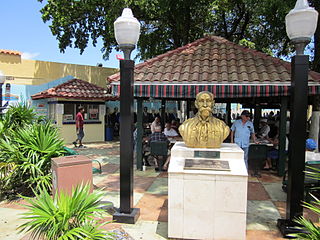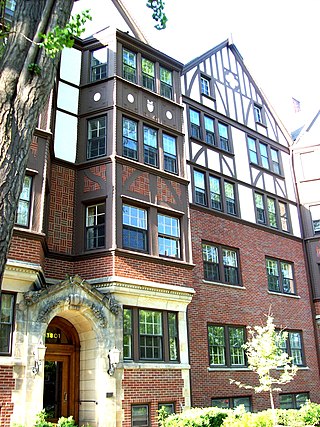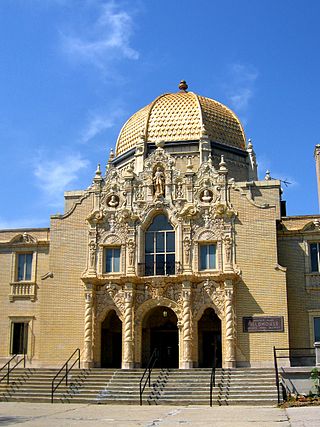Related Research Articles

Granite City is a city in Madison County, Illinois, United States, within the Greater St. Louis metropolitan area. The population was 27,549 at the 2020 census, making it the third-largest city in the Metro East and Southern Illinois regions, behind Belleville and O'Fallon. Officially founded in 1896, Granite City was named by the Niedringhaus brothers, William and Frederick, who established it as a steel making company town for the manufacture of graniteware kitchen utensils.

Polish Americans are Americans who either have total or partial Polish ancestry, or are citizens of the Republic of Poland. There are an estimated 8.81 million self-identified Polish Americans, representing about 2.67% of the U.S. population, according to the 2021 American Community Survey conducted by the U.S. Census Bureau. Polish Americans are the second-largest Central European ethnic group after German Americans, and the eighth largest ethnic group overall in the United States.

Little Saigon is a name given to ethnic enclaves of expatriate Vietnamese mainly in English-speaking countries. Alternate names include Little Vietnam and Little Hanoi, depending on the enclave's political history. To avoid political undertones due to the renaming of Saigon to Ho Chi Minh City, it is occasionally called by the neutral name Vietnamtown. Saigon is the former name of the capital of the former South Vietnam, where a large number of first-generation Vietnamese immigrants arriving to the United States originate, whereas Hanoi is the current capital of Vietnam.

Little Havana is a neighborhood of Miami, Florida, United States. Home to many Cuban exiles, as well as many immigrants from Central and South America, Little Havana is named after Havana, the capital and largest city in Cuba.

Oakland, located on the South Side of Chicago, Illinois, USA, is one of 77 officially designated Chicago community areas. Bordered by 35th and 43rd Streets, Cottage Grove Avenue and Lake Shore Drive, The Oakland area was constructed between 1872 and 1905. Some of Chicago's great old homes may be seen on Drexel Boulevard. The late 19th-century Monument Baptist Church on Oakwood Blvd. is modeled after Boston's Trinity Church. Oakwood /41st Street Beach in Burnham Park is at 4100 S. Lake Shore Drive. With an area of only 0.6 sq mi Oakland is the smallest community area by area in Chicago.
South Omaha is a former city and current district of Omaha, Nebraska, United States. During its initial development phase the town's nickname was "The Magic City" because of the seemingly overnight growth, due to the rapid development of the Union Stockyards. Annexed by the City of Omaha in 1915, the community has numerous historical landmarks many are within the South Omaha Main Street Historic District.

South Philadelphia, nicknamed South Philly, is the section of Philadelphia bounded by South Street to the north, the Delaware River to the east and south, and the Schuylkill River to the west. A diverse working-class community of many neighborhoods, South Philadelphia is well-known for its large Italian-American population, but it also contains large Asian American, Irish-American, African-American, and Latino populations.

Chicago's demographics show that it is a large, and ethnically and culturally diverse metropolis. It is the third largest city and metropolitan area in the United States by population. Chicago was home to over 2.7 million people in 2020, accounting for over 25% of the population in the Chicago metropolitan area, home to approximately 9.6 million.

Buckeye–Shaker is a neighborhood on the East Side of Cleveland, Ohio. It encompasses two sub neighborhoods: in its south and west, the old Buckeye neighborhood; and in its northeast, the Shaker Square neighborhood, which is centered on an historic shopping district and an eponymous rapid transit station, located at the intersection of Shaker and Moreland Boulevards, on the light rail line that connects the city of Shaker Heights to downtown Cleveland. From the early to mid-20th century, the Buckeye Road neighborhood was known as "Little Hungary", serving as the historic heart of Cleveland's Hungarian community, which at one time was the largest in the world outside of Hungary and for years has been almost completely African-American. Shaker Square, continues to be known as one of Cleveland's most notable neighborhoods, in terms of shopping, dining, architecture, the education of its residents, participation in civic life, diversity, and quality of living.

Since its founding in 1625 by Dutch traders as New Amsterdam, New York City has been a major destination for immigrants of many nationalities who have formed ethnic enclaves, neighborhoods dominated by one ethnicity. Freed African American slaves also moved to New York City in the Great Migration and the later Second Great Migration and formed ethnic enclaves. These neighborhoods are set apart from the main city by differences such as food, goods for sale, or even language. Ethnic enclaves provide inhabitants security in work and social opportunities, but limit economic opportunities, do not encourage the development of English speaking, and keep immigrants in their own culture.
Various ethnic groups in Omaha, Nebraska have lived in the city since its organization by Anglo-Americans in 1854. Native Americans of various nations lived in the Omaha territory for centuries before European arrival, and some stayed in the area. The city was founded by white Anglo-Saxon Protestants from neighboring Council Bluffs, Iowa. However, since the first settlement, substantial immigration from all of Europe, migration by African Americans from the Deep South and various ethnic groups from the Eastern United States, and new waves of more recent immigrants from Mexico and Africa have added layers of complexity to the workforce, culture, religious and social fabric of the city.
Lincoln Village is a south side neighborhood within the City of Milwaukee.
The history of Czechs in Baltimore dates back to the mid-19th century. Thousands of Czechs immigrated to East Baltimore during the late 19th and early 20th centuries, becoming an important component of Baltimore's ethnic and cultural heritage. The Czech community has founded a number of cultural institutions to preserve the city's Czech heritage, including a Roman Catholic church, a heritage association, a gymnastics association, an annual festival, a language school, and a cemetery. During the height of the Czech community in the late 19th century and early 20th century, Baltimore was home to 12,000 to 15,000 people of Czech birth or heritage. The population began to decline during the mid-to-late 20th century, as the community assimilated and aged, while many Czech Americans moved to the suburbs of Baltimore. By the 1980s and early 1990s, the former Czech community in East Baltimore had been almost entirely dispersed, though a few remnants of the city's Czech cultural legacy still remain.
The history of Poles in Baltimore dates back to the late 19th century. The Polish community is largely centered in the neighborhoods of Canton, Fell's Point, Locust Point, and Highlandtown. Poles are the largest Slavic ethnic group in the city and one of the largest European ethnic groups.

There have been a variety of ethnic groups in Baltimore, Maryland and its surrounding area for 12,000 years. Prior to European colonization, various Native American nations have lived in the Baltimore area for nearly 3 millennia, with the earliest known Native inhabitants dating to the 10th millennium BCE. Following Baltimore's foundation as a subdivision of the Province of Maryland by British colonial authorities in 1661, the city became home to numerous European settlers and immigrants and their African slaves. Since the first English settlers arrived, substantial immigration from all over Europe, the presence of a deeply rooted community of free black people that was the largest in the pre-Civil War United States, out-migration of African-Americans from the Deep South, out-migration of White Southerners from Appalachia, out-migration of Native Americans from the Southeast such as the Lumbee and the Cherokee, and new waves of more recent immigrants from Latin America, the Caribbean, Asia and Africa have added layers of complexity to the workforce and culture of Baltimore, as well as the religious and ethnic fabric of the city. Baltimore's culture has been described as "the blending of Southern culture and [African-American] migration, Northern industry, and the influx of European immigrants—first mixing at the port and its neighborhoods...Baltimore’s character, it’s uniqueness, the dialect, all of it, is a kind of amalgamation of these very different things coming together—with a little Appalachia thrown in...It’s all threaded through these neighborhoods", according to the American studies academic Mary Rizzo.
The history of Russians in Baltimore dates back to the mid-19th century. The Russian community is a growing population and constitutes a major source of new immigrants to the city. Historically the Russian community was centered in East Baltimore, but most Russians now live in Northwest Baltimore's Arlington neighborhood and in Baltimore's suburb of Pikesville.
At the end of the 20th century there were a total of 270,000 Jews in the Chicago area, with 30% in the city limits. In 1995, over 80% of the suburban Jewish population lived in the northern and northwestern suburbs of Chicago. At this time, West Rogers Park was the largest Jewish community within the city of Chicago. However, the Jewish population within the city had been declining and tended to be older and more well-educated than the Chicago average. The Jewish immigrants to Chicago came from many different countries, with the most common being Eastern Europe and Germany.

Metro Detroit has the following ethnic groups:

The West Side is one of the three major sections of the city of Chicago, Illinois, U.S. The other two sections within Chicago that associate with the West Side are the North Side and the South Side. The West Side consists of communities that are of historical, cultural, and ideological importance to the history and development of Chicago. On the flag of Chicago, the West Side is represented by the central white stripe.

The history of White Americans in Baltimore dates back to the 17th century when the first white European colonists came to what is now Maryland and established the Province of Maryland on what was then Native American land. White Americans in Baltimore are Baltimoreans "having origins in any of the original peoples of Europe, the Middle East or North Africa." Majority white for most of its history, Baltimore no longer had a white majority by the 1970s. As of the 2010 census, white Americans are a minority population of Baltimore at 29.6% of the population. White Americans have played a substantial impact on the culture, dialect, ethnic heritage, history, politics, and music of the city. Since the earliest English settlers arrived on the shores of the Chesapeake Bay, Baltimore's white population has been sustained by substantial immigration from all over Europe, particularly Central Europe, Eastern Europe, and Southern Europe, as well as a large out-migration of White Southerners from Appalachia. Numerous white immigrants from Europe and the European diaspora have immigrated to Baltimore from the United Kingdom, Germany, Ireland, Poland, Italy, the Czech Republic, Slovakia, Lithuania, Russia, Ukraine, Spain, France, Canada, and other countries, particularly during the late 19th century and early 20th century. Smaller numbers of white people have immigrated from Latin America, the Caribbean, the Middle East, North Africa, and other non-European regions. Baltimore also has a prominent population of white Jews of European descent, mostly with roots in Central and Eastern Europe. There is a smaller population of white Middle Easterners and white North Africans, most of whom are Arab, Persian, Israeli, or Turkish. The distribution of White Americans in Central and Southeast Baltimore is sometimes called "The White L", while the distribution of African Americans in East and West Baltimore is called "The Black Butterfly."
References
- ↑ Tim Fox, Where We Live: A Guide to Saint Louis Communities (Missouri Historical Society, 1995).
- ↑ Graham Taylor, Satellite Cities: A Study of Industrial Suburbs, (1915), 151.
- ↑ Dan Manoyan, Men of Granite, Authorhouse, 2007.
- ↑ Schedule of Events for the 2008-2009 Lincoln Place Heritage Festival